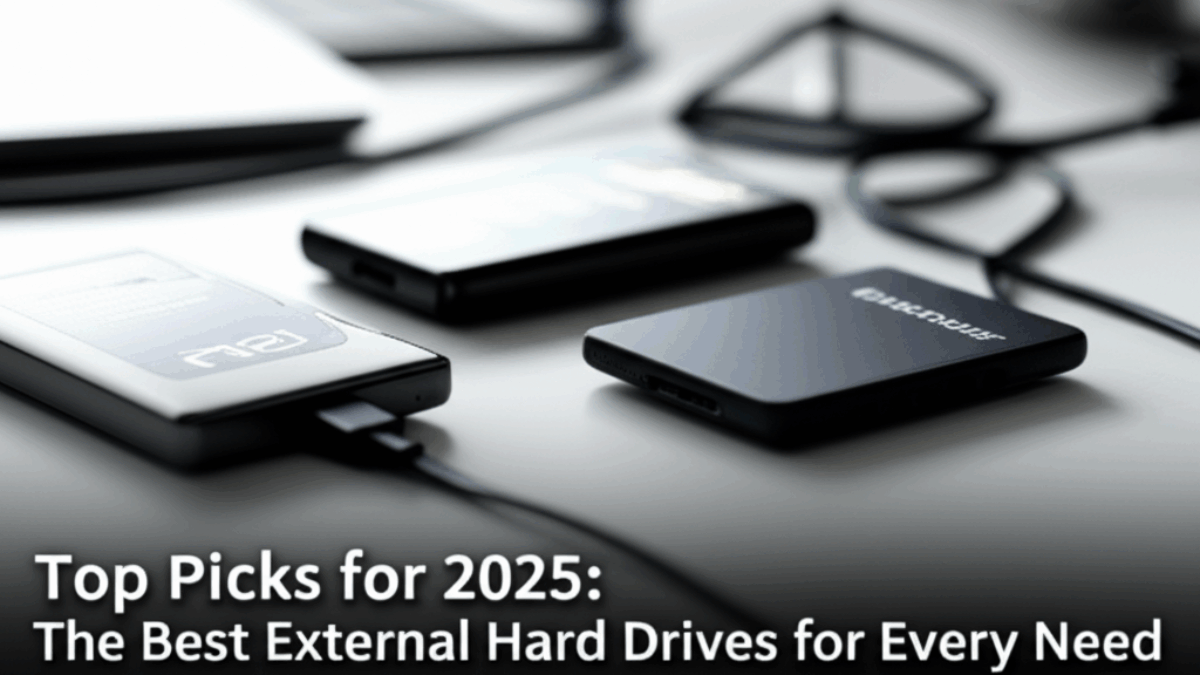Introduction: Why External Hard Drives are Trending
In an age where data is king, the need for reliable storage solutions has never been more critical. As digital content creation continues to rise—with videos, high-resolution photos, and massive games demanding more space—external hard drives are becoming increasingly essential. Whether you’re a student juggling projects, a professional safeguarding sensitive files, or a gamer craving space for your latest title, finding the right external hard drive can make all the difference.
As we step into 2025, the market is flooded with innovative options, each promising speed, capacity, and reliability. But how do you choose among them? In this comprehensive guide, we will explore key features to look for, compare top products, and provide expert recommendations tailored to your specific needs.
Key Features to Look For in External Hard Drives
When searching for an external hard drive, it’s important to understand the various features that can influence your choice. Here’s a detailed breakdown:
1. Storage Capacity
- Explanation: External hard drives typically range from 256GB to several terabytes (TB). Assess your storage needs based on what you’ll be storing: documents, media, software, or games.
- Tip: Opt for a drive with at least double the storage you estimate you will need in the next few years.
2. Transfer Speeds
- Explanation: Measured in megabytes per second (MB/s), transfer speed can significantly affect how quickly you can move files. Look for USB 3.0 or 3.1 connections for faster performance.
- Tip: Solid State Drives (SSDs) generally offer faster speeds compared to traditional Hard Disk Drives (HDDs) but at a higher cost.
3. Form Factor
- Explanation: External drives come in various sizes. Portable drives are sleek and mobile, while desktop drives often provide more storage but require external power.
- Tip: Choose a portable drive for travel and a desktop drive for home use if you need greater capacity.
4. Durability
- Explanation: Consider how robust the drive is, especially if you plan to transport it frequently. Look for rugged designs or drives with protective casings.
- Tip: Drives with water and shock resistance can save you from losses due to accidents.
5. Interface
- Explanation: Common interfaces include USB-C, USB 3.0, and Thunderbolt. More modern interfaces offer faster data transfer rates but ensure compatibility with your devices.
- Tip: USB-C is becoming the industry standard for new devices, but keep in mind older versions for legacy compatibility.
6. Security Features
- Explanation: Data encryption and password protection are vital for safeguarding sensitive information. Some drives come with built-in security protocols.
- Tip: Consider drives with hardware encryption if you store confidential material.
7. Price and Warranty
- Explanation: Prices can vary widely based on capacity and speed. Generally, higher capacity and faster drives are more expensive. A good warranty can provide peace of mind.
- Tip: Look for drives that offer at least a two-year warranty; this can indicate better reliability.
Comparison of Top Products in the Market
Now that you know what features to look for, let’s dive into a comparison of the top external hard drives available in 2025.
| Product Name | Storage Capacity | Type | Transfer Speed | Price Range | Pros | Cons |
|---|---|---|---|---|---|---|
| Samsung T7 SSD | 500GB to 2TB | SSD | Up to 1050 MB/s | $$ | Ultra-fast, compact, durable | Pricey for higher capacities |
| WD My Passport | 1TB to 5TB | HDD | Up to 540 MB/s | $ | Affordable, simple, reliable | Slower speeds compared to SSDs |
| Seagate Expansion Desktop | 4TB to 10TB | HDD | Up to 160 MB/s | $$ | Massive capacity, easy to use | Bulky and not portable |
| LaCie Rugged SSD | 1TB to 5TB | SSD | Up to 1050 MB/s | $$$ | Exceptional durability, fast speeds | Higher cost |
| SanDisk Extreme Portable SSD | 500GB to 4TB | SSD | Up to 1050 MB/s | $$ | Compact design, fast speeds | Limited capacity options under $100 |
Product Breakdown
1. Samsung T7 SSD
- Pros: The Samsung T7 offers lightning-fast transfer speeds and comes in a sleek and compact design that’s perfect for on-the-go professionals.
- Cons: However, its price may be on the higher end, especially for larger capacities.
2. WD My Passport
- Pros: Known for its affordability and reliability, the WD My Passport provides ample storage for everyday users without breaking the bank.
- Cons: It does offer slower performance compared to SSDs, making it less ideal for heavy media users.
3. Seagate Expansion Desktop
- Pros: Perfect for users needing extensive storage, the Seagate Expansion Desktop is ideal for backups and media libraries.
- Cons: Its bulkiness makes it less suitable for those requiring a portable solution.
4. LaCie Rugged SSD
- Pros: This drive excels in durability and performance, making it a favorite for photographers and content creators who often find themselves in unpredictable environments.
- Cons: The premium price might deter budget-conscious users.
5. SanDisk Extreme Portable SSD
- Pros: With a design that caters to outdoor use, the SanDisk Extreme is compact, durable, and offers fast speeds.
- Cons: There are limited options for budget-friendly models.
Use-Case Scenarios
To help you decide which external hard drive best suits your lifestyle, let’s explore various use-case scenarios:
1. For Students
- Best Pick: WD My Passport
- Reason: Students need a reliable and affordable option for storing assignments and files. The WD My Passport offers ample space for projects and is budget-friendly.
2. For Professionals
- Best Pick: Samsung T7 SSD
- Reason: Professionals often require quick access to large files. The T7’s exceptional transfer speeds and portability make it ideal for presentations and collaborations on the go.
3. For Gamers
- Best Pick: Seagate Expansion Desktop
- Reason: Gamers accumulate large libraries of titles. The high capacity and affordability of the Seagate Expansion make it suitable for storing multiple games while still being budget-friendly.
4. For Creatives
- Best Pick: LaCie Rugged SSD
- Reason: Photographers and videographers need durable storage that can handle rough conditions. The LaCie Rugged SSD offers both performance and resilience, protecting valuable files.
5. For General Users
- Best Pick: SanDisk Extreme Portable SSD
- Reason: For everyday users seeking a balance between performance and portability, the SanDisk Extreme Portable SSD is an excellent choice.
Expert Recommendations on Budget vs Premium Choices
Budget Choices
-
WD My Passport
- Why: Provides essential features for everyday users. It’s affordable, reliable, and offers ample storage space.
- Seagate Expansion Desktop
- Why: Ideal for users who need large amounts of storage on a budget. It’s easy to use and affordable.
Premium Choices
-
Samsung T7 SSD
- Why: For those who prioritize speed and portability, this device offers unbeatable performance.
- LaCie Rugged SSD
- Why: The rugged design and high performance make it perfect for creative professionals who need reliable storage in challenging environments.
FAQs
1. What is the difference between HDD and SSD?
HDDs (Hard Disk Drives) are traditional spinning disks, while SSDs (Solid State Drives) use flash memory. SSDs offer faster speeds, are more shock-resistant, and generally have lower latency.
2. Can I use an external hard drive with my gaming console?
Yes, most modern gaming consoles support external hard drives for additional storage. Ensure the drive is formatted as required by the console.
3. How do I back up my data to an external hard drive?
Simply connect the drive to your computer, and use built-in backup software (like Windows Backup or Time Machine on Mac) or drag and drop files manually.
4. Are external hard drives compatible with Macs and PCs?
Most external hard drives are designed to work with both, but check the formatting. Drives formatted in NTFS may need to be reformatted for macOS compatibility.
5. How can I improve the lifespan of my external hard drive?
Keep your drive in a cool, dry place, avoid physical shocks, and safely eject it before disconnecting it from your computer.
Buyer’s Checklist for Quick Decision-Making
- Determine Storage Needs: Estimate how much capacity you’ll need.
- Consider Speed Requirements: Decide if you need fast speeds (SSD) or if standard (HDD) will suffice.
- Assess Portability: Will you transport the drive frequently? Choose accordingly.
- Evaluate Durability: If you’re prone to accidents, consider rugged options.
- Budget: Set a price range and look for the best options within that range.
In conclusion, selecting the right external hard drive boils down to understanding your specific needs. Whether you’re a student, professional, or gamer, the best HDD or SSD can enhance your productivity and secure your precious data. By keeping an eye on important features and considering your unique requirements, you can find an external hard drive that perfectly fits your lifestyle in 2025. Happy storing!

